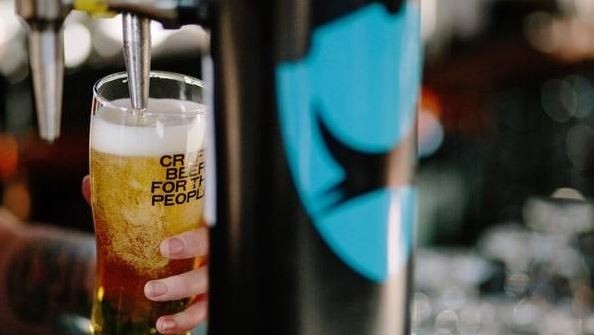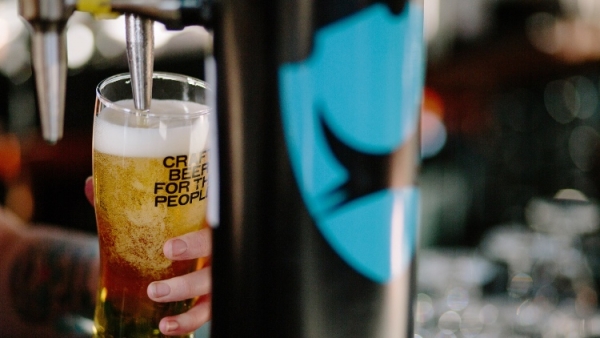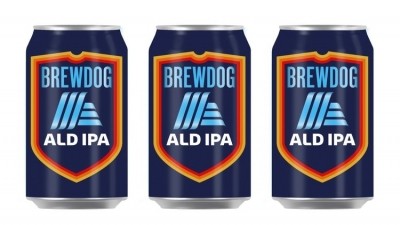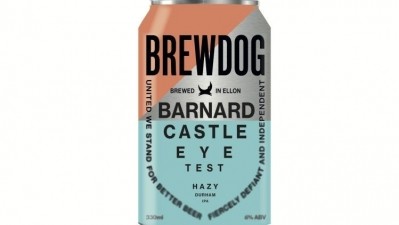In association with BrewDog
Why draught alcohol-free beer is a winner

In light of successful alcohol-free launches including Punk AF, Hazy AF and coffee stout Wake Up Call – as well as an alcohol-free bar opened for Dry January 2020 – no one can accuse BrewDog of not picking up new tricks as it enters its 14th year.
Having launched Nanny State more than a decade ago, the Scottish craft brewer – which gate-crashed Brand Finance’s list of the worlds’ 25 most valuable beer brands in June 2019 – has poured over its range and used a number of existing products to inspire a new breed of alcohol-free brews.
“We passionately believe that within this category people should still have awesome craft beer, just alcohol-free,” co-founder James Watt explains. “At BrewDog, we are on a mission to prove that alcohol-free does not equate to taste-free.”
Given the size of the prize, it’s easy to see why the independent brewer and pub operator’s approach to the low and no category is serious AF.
Beer and cider under 3.5% ABV grew by 37.2% in volume and 46.4% in value during 2019 according to CGA data published in the 2019 Beer Report, with Drinkaware finding that almost three quarters (72%) of adults who consumed less alcohol or stopped drinking during Dry January 2020 are planning to do so long term.
On top of this, more than a third (38%) of drinkers who were planning to cut down on their alcohol consumption said they would have drink-free days during the week according to Drinkaware – with KAM Media research finding that three quarters (74%) of consumers would consider purchasing alcohol-free beer if it were available in pubs and bars.
How BrewDog is changing the AF category?
AF in numbers
- Beers and ciders under 3.5% ABV grew by 37.2% in volume and 46.4% in value during 2019 (source: CGA, 2019 Beer Report)
- Seven in 10 (74%) consumers would consider purchasing alcohol-free beer if it were available in pubs and bars. (Source: KAM Media)
- Almost three quarters (72%) of adults who consumed less alcohol or stopped drinking during Dry January 2020 plan to do so long term (Source: Drinkaware)
- A third of current pub and bar customers are frustrated that draught alcohol-free beer isn’t available in the pubs and bars they currently visit (Source: KAM Media)
- 86% of consumers consider draught alcohol-free beer to be better or on a par with the quality of canned or bottled equivalents (Source: KAM Media)
- More than a third (38%) of drinkers who were planning to cut down said they would have drink-free days during the week (Source: Drinkaware)
- More than half (53%) of all pub and bar customers say that alcohol-free beer on draught would make pubs more appealing places to visit (Source: KAM Media)
- Half (51%) of alcohol-free beer drinkers are frustrated that their beer of choice is not available on draught in the pubs and bars they visit (Source: KAM Media)
- One-in-four pub visits are now alcohol-free (Source: KAM Media)
- Alcohol-free beer can deliver an additional £72m to the pub and bar channel (Source: KAM Media)
With its Punk IPA top dog in the craft category according to The Morning Advertiser’s latest Drinks List after selling around 3.3m more pints of its flagship IPA in 2019, generating almost £15m more in YOY value, BrewDog has made waves in the alcohol-free category with a number of eye-catching launches.
The evidence so far suggests BrewDog is far from barking up the wrong tree. All you have to do is look at the stats, for example, according to Kam Media, 51% of drinkers have voiced their frustration that AF on draught is not available in pubs and bars. While 53% said having it on draught would make pubs and bars more appealing to visit.
“BrewDog was one of the first craft brewers to really change this category way back in 2009 with the release of Nanny State, which is the UK’s best-selling alcohol-free craft beer,” according to Watt.
“We then followed up with an alcohol-free version of our flagship Punk IPA, Punk AF, which has become the number one NPD product for total craft beer this year
“Since then we have expanded our range with the addition of a limited release of Hazy AF, an alcohol-free take on our New England IPA Hazy Jane, and most recently Lost AF – where we’ve taken our iconic Lost Lager and turned it in to crisp and refreshing 0.5% crusher.”
Defying customer expectations
According to BrewDog Shoreditch’s Dave Bruce, the company-wide understanding that the beer experience “should never be sold short” naturally extends to its no-alcohol pours despite drinker preconceptions about the category.
“Whenever you say something is 'without', whether that be alcohol free, gluten free, there's the indication that the product is missing something, and it isn't a finished article,” he says. “But genuinely it's been eye-opening.
“Just having a diverse product range means that people aren't being stuck with the same choices on a daily basis – it's like going into an amazing restaurant and just having lasagne every day because there's nothing else you can have,” Bruce continues.
“Actually, there's a range there, you don't have to be shackled to one product because of your choices - no style is left behind, everything is enjoyed and certainly experimented with.”
On top of this, according to Rachel Thomas of BrewDog Clerkenwell – which poured the highest percentage of alcohol-free beers out of BrewDog’s London sites in Dry January barring it’s entirely alcohol free site – having alcohol free beer front and centre on a bar top, served on draught, and presented in pint glasses, can encourage customers to feel less awkward about asking for an alcohol-free pour.
“I think a lot of people sometimes feel embarrassed or judged having an alcohol-free beer, so I think it removes that,” she says.
Who drinks AF?
According to Bruce, an expanded alcohol-free range helps cater for the increasing number of customers who cross his bar’s threshold with no intention of consuming alcohol – either due to health conditions or made specific lifestyle choices.
“People that may no longer consume alcohol for whatever reason, whether that's through choice or necessity,” he explains. “It's people that maybe aren't drinking alcohol for a set amount of time – whether they are pregnant or are going through lifestyle changes or choices.
What’s more, Thomas adds that given roughly 70% of her bar’s customers work in the offices that surround her bar, alcohol-free pints offer professionals in her City of London site the chance to head out for a lunchtime pint without risking an afternoon slump.
“I think a lot of people come out for a pint on their lunch, maybe they'll have a pint of alcoholic beer and then a pint of alcohol-free beer,” she says. “You can go back to work and do your business meetings properly afterwards."
Can an alcohol-free beer be sold on a traditional draught dispense system?
“The answer is yes, it can, but as with everything, there will be anomalies,” Richard Cousins of Three Nations dispense brewery technical services explains.
“Traditional dispense systems are designed to deliver draught products at a low in glass temperature, based on the specification for the brand, set by the brewer.
“These products are able to withstand these very low temperatures because of their alcoholic content and the fact that they are carbonated, which lowers the freezing point of the liquid from that at which water will freeze.
“Alcohol Free products will freeze slightly below 0 based on the fact that they are carbonated. The degree to which this freezing is affected depends on the temperature at which the product was carbonated and the level of carbonation.
“Traditional line cooling systems will either further chill products stored in a cooled cellar at between 11-13oC or maintain this level using a system comprising an insulated loom of product lines which are wrapped around a set of water lines circulating cold water or other coolant from a cooling unit to the end point of the bar and back.
“Where products require additional cooling, they will be run through the cooler using a varying length stainless steel coil and connected to a line which is closest to the circulating water lines.
“With an alcohol-free product, any system that reduces the temperature to a level where, in particular, stationary product (during periods between licensing hours) may lower to a degree that it starts to freeze, would need to be avoided.
“Certainly, any additional cooling, achieved by running through coils on a cooler, would need to be avoided and ideally, only lines sitting at the extremities of the loom used.
“Any cooling level reached where partial freezing may occur will have a detrimental effect on both the dispense of the brand, the presentation and palate.
“Ideally a dispense temperature of 3-4oC should deliver a quality product. Other dispense options would be via a standalone keg line from the cellar and a small undercounter cooler, set to deliver at the required temperature range.”
Future of AF at BrewDog?
Thomas adds that as demand for premium no-alcohol serves continues to soar, the frequency with which BrewDog reaches thirsty customers through both its own tech and app partners should grow with it.
"I see quite a lot of alcohol free beers being delivered on our BrewDog Now app, Deliveroo and Uber and I think that's maybe because some of the supermarkets don't have the space to have chilled alcohol free beer available – so they can get it chilled from us, direct to their door."
Additionally, while Bruce has recognised the importance of alcohol-free throughout his tenure at BrewDog’s Shoreditch site, he sees the restocked AF offer as having an impact far beyond the craft brewer’s bottom line.
"I've worked for this company for over five years and for the majority of that time, with any bar I've run having an alcohol-free option – in particular on draught – has been really important. The sales hold their own and they very much keep their own place on the bar locked down.
"The positive impact of them being available is huge. The conversations it can open up while drinkers are in my bar, or the countless conversations it opens up once consumers leave our front door. Who are they telling, who are they talking to this about? The impact goes way beyond finance and goes way beyond our stock volume that we're selling.
“Earlier this year we opened BrewDog AF, the world’s first alcohol free beer bar which offered 15 taps of draft alcohol-free craft beer in central London,” Watt adds.
“This is a pilot concept and results from the beginning of the year showed a positive appetite for this sort of outlet. We have since re-opened our bar and are offering a wide variety of alcohol-free beers from BrewDog and guest breweries, as well as alcohol-free spirits and wine.
“Our BrewDog AF range is all about changing perceptions and offering a new choice to drinkers. We are offering an alternative for everyone; whether they may be cutting out, cutting back or just want to try something different.”










